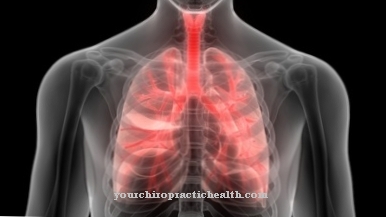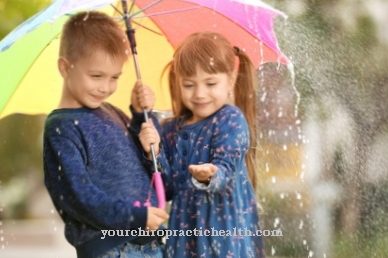At the cry but the tear glands of the eyes increasingly release tear fluid. When there are foreign bodies in the eye, crying is a physical protective reflex. Emotional tears differ from these reflex tears in their composition and presumably serve for social interaction.
What is that crying

Crying is a body reflex as well as an emotional expression. When crying, the tear glands in the tear system of the eyes reflexively produce excessive tear fluid. This can happen for physiological protection if, for example, a foreign body has fallen on the eye. For example, people cry when they are caught by a mosquito. The tear fluid washes the foreign body out of the eye to prevent inflammation.
On the other hand, people cry for emotional reasons too. Excessive joy, emotion or anger, but also emotional pain can cause a person to cry.
The tear fluid from the lacrimal glands is a salty body fluid. Their chemical composition may differ depending on the cause of the tears. Emotional tears contain more hormones and proteins. The concentration of potassium and manganese is also higher in emotional tears than in reflex tears.
As an archetypal form of expression, people can understand tears regardless of their culture or geographical origin. The interpretation of the occasion usually takes place in connection with the accompanying facial expressions.
Function & task
The tactile cells on the conjunctiva of the eyes can detect touch stimuli. For example, humans notice foreign bodies in the eye. When the sensory cells report a foreign body in the eye, they transmit the stimulus they have picked up to the brain via biochemical processes. The parasympathetic nervous system then prompts the lacrimal glands to increase the production of tear fluid, so that the reflex tears wash foreign bodies out of the eye.
Apart from that, they also use the substance lysozyme to ward off pathogens in the visual system. This form of crying protects the eye from disease and inflammation. Ultimately, reflex tears help maintain eyesight and protect the body in general.
Doctors like William Frey also said that emotional tears had protective effects until the 1980s. Frey was of the opinion that the body would detoxify harmful substances through the tear fluid. For example, unhealthy proteins are produced during grief and anger. According to Frey, the tears should break down these substances and protect the body from oxidative stress.
Empirical studies have now shown proteins in emotional tears. The concentration of these proteins is too low to speak of detoxification. To this day, the meaning of emotional tears is therefore controversial. Supporters of the protective reaction theory now see general stress reduction as the task of emotional tears. Crying should enable a so-called "catharsis" effect. The crying lets out everything that has emotionalized him and should be able to relieve tension and stress. This should ease the psyche and allow relaxation to occur.
However, this theory contradicts the fact that crying itself causes great stress on the body. Instead of relaxation, tears often create even greater tension. Studies show that hardly anyone feels relieved after crying. Many people feel even worse afterwards.
The physiological explanatory approaches are therefore today contrasted with evolutionary biological approaches. According to them, crying is a form of social behavior, i.e. communication and social interaction.
It has been proven that emotions reach the other person more intensely when they are accompanied by tears. That makes tears a signal to the environment. An Israeli study from 2011 even found that tears contain chemical messengers for silent communication. The crying person automatically influences the behavior of his environment. This influence usually takes place on an unconscious level. The other person also unconsciously adapts their behavior to the tears.
Apparently contrary to this observation is the connection between tears and weakness. If crying served communication and social interaction, why would someone who cry constantly be socially discredited as weak? Researchers assume that this connection goes back to socialization, i.e. the societal learning of meanings.
You can find your medication here
➔ Medicines for eye infectionsIllnesses & ailments
Symptoms related to crying are most often associated with mental illness. For example, some people can no longer cry emotionally. Depression can lead to absolute paralysis, depending on the nature of the patient.
On the other hand, the opposite can also be the case. Sometimes depressed people also cry more intensely. Increased crying is partly due to a nervous breakdown. A nervous breakdown usually results from a psychological stressful situation. The person concerned usually does not have any suitable coping strategies for this extreme stress situation. Because of the physical stress overload, crying fits and tremors occur. Sweating, nausea, headaches, palpitations and nervousness can accompany the crying spasms. Those affected often feel helpless and emptiness.Sometimes they only see their own life from the outside.
After a month, a nervous breakdown sometimes turns into post-traumatic stress disorder. Particularly in children, there could also be an attention deficit disorder in connection with pathological crying.
In rare cases, pathological weeping attacks with amyotrophic lateral sclerosis (ALS) occur. With ALS, the motor nerve tracts are destroyed piece by piece. The reason for this is still unclear. In addition to uncontrollable and involuntary crying and laughing, ALS triggers muscle weakness and later also paralysis.

.jpg)

























